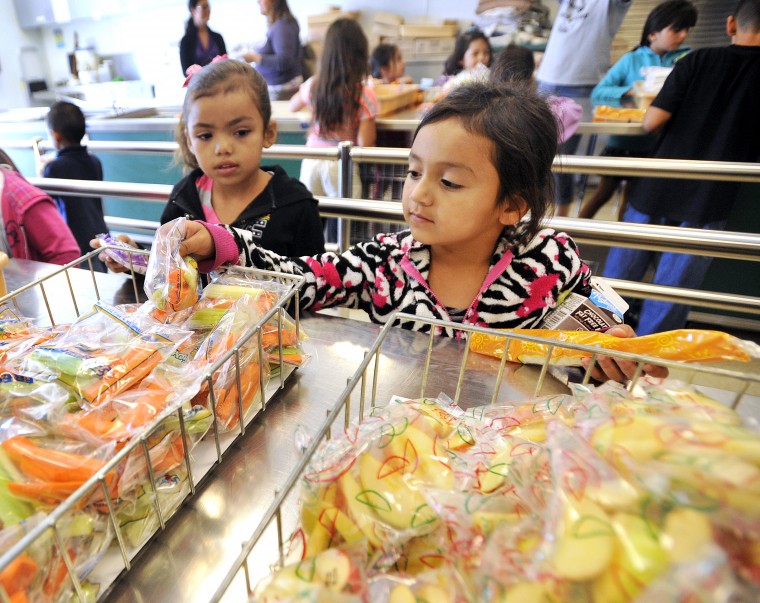
Hollister School District students are making healthier lunch choices this year. At midday at Sunnyslope Elementary School on Tuesday, the first grade students selected between sliced apples or carrot and celery sticks, with some taking both items. Each day of the week the students see a different vegetable offering – leafy dark greens, red and orange vegetables, beans or peas, starchy vegetables and others.
In recent weeks, the students have been offered jicama, three-bean salad, cucumbers and corn. One of the big hits with the students has been a salad in a bag – romaine lettuce and cherry tomatoes served in a plastic bag with a perforated top.
“The kids like tearing off the strip and adding in the low-fat dressing, then eating it out of the bag,” said Janet Felice, the director of Student Nutrition, Maintenance & Operations, and Warehouse Services for HSD.
For students in kindergarten through eighth grade, schools are required to serve two-and-a-half cups of fruit each week and 3-3/4 cups of vegetables. The vegetables can be served raw or cooked. High school students are provided with five cups of fruits and five cups of vegetables a week.
“Basically we need to provide a variety,” Felice said. “The other big thing is students used to be able to decline a fruit or vegetable, but now they have to take at least three out of the five items. They have to have one fruit or vegetable.”
Starting this year, school districts around the nation were required to make some fundamental changes when the federal lunch program was reauthorized in 2010. Schools were given two years to work with vendors in preparation of the changes implemented this year, with more to come over the next decade.
Hollister School District had a head start since they had already implemented some of the changes before Congress authorized the Healthy, Hunger-Free Kids Act of 2010 to require at least 50 percent of grains be whole grain-rich and allowing only 1 percent milk or nonfat flavored milk be offered with both lunch or breakfast meals. The changes also lowered the calorie requirement for lunches, lowered the number of trans fats per portion to zero, and changed the schools to a three-year administrative cycle for review.
More than 66 percent of Hollister School District students are enrolled in the free or reduced lunch program.
Felice said she has been purchasing produce locally and working with a Fresno-based company to package it for distribution. They had already worked with Fresno Produce Co. to package sliced apples. The company slices up the fresh produce and packages it into individual serving bags, which are delivered to local schools twice a week.
“It’s still a challenge,” said Felice. “For example, I ordered cucumbers but they haven’t gotten to the correct ripeness so (Fresno Produce Company) subbed for something else but it was not an item in the same sub category. It used to be as long as they had a vegetable, we were in compliance.”
She said another challenge is making sure some vegetables are served when they are still fresh. She said with cucumbers they often have to be served the day the shipment arrives so they don’t go bad. Felice has told the food service employees at each school they can swap items within the week as long as they make sure each subcategory is represented once a week.
“They (the students) seem to like the jicama,” Felice said. “They typically like carrots. They like carrot sticks better than baby carrots.”
On the recent weekday, the return cart where students can return unopened food items they picked up with their lunch, was nearly empty except for a few bags of apples.
The reimbursement per lunch increased by 6 cents per meal this year.
“The prices are doable in the budget for right now,” Felice said. “I think it would be less expensive if I could package it myself. I’d like to buy it in bulk and package it myself.”
She said she is looking into opening a centralized kitchen in the district that would allow food preparation such as slicing and packaging fruits and vegetables, as well as adding more vegetables to the entrees.
In the coming years, Felice will also have to incorporated changes to the breakfast program that include adding in more fruit, as well as more changes to the lunch and breakfast programs. They include serving only whole grain-rich foods by 2014 and lowering sodium targets starting in 2014, through 2022.
Felice said last spring that some of the vendors were having issues with bringing down the sodium levels because of the naturally occurring sodium in some items.
For now, the school lunch providers are focused on the changes for this year.
“I went to a menu certification class and everyone is having the same challenges,” Felice said, “But in a year or two we will look back and this will just be the way we do it.”









